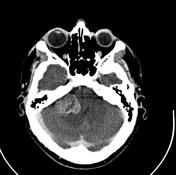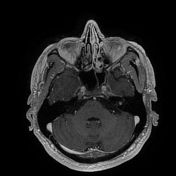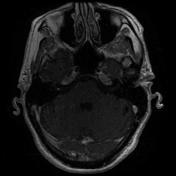Acoustic neuroma MRI: Difference between revisions
Simrat Sarai (talk | contribs) No edit summary |
Simrat Sarai (talk | contribs) No edit summary |
||
| Line 36: | Line 36: | ||
Post-up MRI:Linear enhancement may not indicate tumour, but if there is nodular enhancement suspect tumour recurrence (needs follow up MRI). <ref>{{Cite web | title =Radiopedia acoustic neuroma radiographic features| url =http://radiopaedia.org/articles/acoustic-schwannoma }}</ref> | Post-up MRI:Linear enhancement may not indicate tumour, but if there is nodular enhancement suspect tumour recurrence (needs follow up MRI). <ref>{{Cite web | title =Radiopedia acoustic neuroma radiographic features| url =http://radiopaedia.org/articles/acoustic-schwannoma }}</ref> | ||
[[File:C12bd62d45ee743445f65e9820ab2a_thumb.jpg|none| | [[File:C12bd62d45ee743445f65e9820ab2a_thumb.jpg|none|100px|CT scan showing multiple small and large bowel polyps (arrows) as well as multiple renal angiomyolipomas in left kidney.]] [[File:B645ae2a606f34f636f56fe821f0c0_thumb.jpg|none|100px|CT scan showing multiple small and large bowel polyps (arrows) as well as multiple renal angiomyolipomas in left kidney.]] [[File:7319f4953df173247b89b91f78be52_thumb.jpg|none|100px|CT scan showing multiple small and large bowel polyps (arrows) as well as multiple renal angiomyolipomas in left kidney.]] [[File:53704cf488a848544c186cae250f65_thumb.jpg|none|100px|CT scan showing multiple small and large bowel polyps (arrows) as well as multiple renal angiomyolipomas in left kidney.]] | ||
==References== | ==References== | ||
{{reflist|2}} | {{reflist|2}} | ||
Revision as of 14:45, 18 September 2015
|
Acoustic neuroma Microchapters | |
|
Diagnosis | |
|---|---|
|
Treatment | |
|
Case Studies | |
|
Acoustic neuroma MRI On the Web | |
|
American Roentgen Ray Society Images of Acoustic neuroma MRI | |
Editor-In-Chief: C. Michael Gibson, M.S., M.D. [1]Associate Editor(s)-in-Chief: Simrat Sarai, M.D. [2]
Overview
Gadolinium-enhanced MRI scan is diagnostic of Acoutic neuroma. On brain MRI, glioblastoma is characterized by hypointense mass on T1-weighted MRI and hyperintense mass on T2-weighted MRI
MRI
Magnetic resonance imaging (MRI) using Gadolinium as an enhancing contrast material is the preferred diagnostic test for identifying acoustic neuromas. The image formed clearly defines an acoustic neuroma if it is present and this technique can identify tumors measuring only a few millimeters in diameter. Tumors as small as 1-2 mm in diameter can be demonstrated by well performed MRI scanning. Nonenhanced MRI can miss small tumors.[1]
| MRI component | Features |
|---|---|
|
|
|
|
|
|
Post-up MRI:Linear enhancement may not indicate tumour, but if there is nodular enhancement suspect tumour recurrence (needs follow up MRI). [2]


